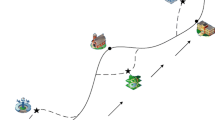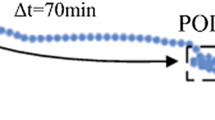Abstract
With the rising prevalence of location-aware devices such as mobile phones, Radio-Frequency Identification (RFID) tags, and Global Positioning Systems (GPSs), the amount of trajectory data is significantly increasing, resulting in various data mining applications. Improper publication of trajectory data may jeopardize the privacy of moving objects, so trajectories ought to be anonymized before making them accessible to the public. Many existing approaches for privacy-preserving publication of trajectory data provide only the same level of privacy protection for all moving objects, whereas different moving objects may require different amounts of privacy protection. In this paper, we address this issue by presenting WINR2D, a novel clustering-based approach for privacy-preserving publication of trajectory data. Being based on the concept of personalized privacy, the aim of WINR2D is to anonymize trajectories to some extent so that an adversary having some background knowledge cannot uniquely identify a specific trajectory, but with a maximum probability inversely proportional to the privacy protection requirement of the moving object that produced it. In doing so, we first assign a privacy level to each trajectory based on the privacy protection requirement of its moving object and then partition all the trajectories into a set of clusters based on a greedy strategy. Each cluster is created such that its size is proportional to the highest privacy level of trajectories within it. Eventually, we anonymize the trajectories of each cluster and generate a set of anonymized trajectories containing generalized and distorted moving points. Our experimental results show that WINR2D achieves a reasonable trade-off between the conflicting goals of data utility and data privacy according to the privacy protection requirements of moving objects.














Similar content being viewed by others
References
Clemm, A., Zhani, M.F., Boutaba, R.: Network management 2030: operations and control of network 2030 services. J. Netw. Syst. Manage. 28(2), 721–750 (2020). https://doi.org/10.1007/s10922-020-09517-0
Otoum, S., Al-Ridhawi, I., Mouftah, H.: Securing critical IoT infrastructures with blockchain-supported federated learning. IEEE Internet Things J. (2021). https://doi.org/10.1109/JIOT.2021.3088056
Leonhardt, U., Magee, J.: Security considerations for a distributed location service. J. Netw. Syst. Manage. 6(1), 51–70 (1998). https://doi.org/10.1023/A:1018777802208
Lee, J.-G., Han, J., Whang, K.-Y.: Trajectory clustering: A partition-and-group framework, In: Proceedings of the 2007 ACM SIGMOD International Conference on Management of Data, ACM, New York, NY, pp. 593–604 (2007). https://doi.org/10.1145/1247480.1247546
Zheng, Y.: Trajectory data mining: an overview. ACM Trans. Intell. Syst. Technol. 6(3), 29:1–29:41 (2015). https://doi.org/10.1145/2743025
Atluri, G., Karpatne, A., Kumar, V.: Spatio-temporal data mining: A survey of problems and methods. ACM Computing Surveys 51(4), 83:1–83:41 (2018). https://doi.org/10.1145/3161602
Samarati, P.: Protecting respondents’ identities in microdata release. IEEE Trans. Knowl. Data Eng. 13(6), 1010–1027 (2001). https://doi.org/10.1109/69.971193
Sweeney, L.: k-anonymity: a model for protecting privacy. Int. J. Uncertain. Fuzziness Knowledge-Based Syst. 10(5), 557–570 (2002). https://doi.org/10.1142/S0218488502001648
Mahdavifar, S., Abadi, M., Kahani, M., Mahdikhani, H.: A clustering-based approach for personalized privacy preserving publication of moving object trajectory data. In: Xu, L., Bertino, E., Mu, Y. (eds.) Network and System Security Lecture Notes in Computer Science, pp. 149–165. Springer, Berlin (2012). https://doi.org/10.1007/978-3-642-34601-9_12
Machanavajjhala, A., Kifer, D., Gehrke, J., Venkitasubramaniam, M.: l-diversity: privacy beyond k-anonymity. ACM Trans. Knowl. Discov. from Data 1(1), 3:1–3:52 (2007). https://doi.org/10.1145/1217299.1217302
Gurung, S., Lin, D., Jiang, W., Hurson, A., Zhang, R.: Traffic information publication with privacy preservation. ACM Trans. Intell. Syst. Technol. 5(3), 44:1–44:26 (2014). https://doi.org/10.1145/2542666
Ghasemi Komishani, E., Abadi, M., Deldar, F.: PPTD: preserving personalized privacy in trajectory data publishing by sensitive attribute generalization and trajectory local suppression. Knowledge-Based Syst. 94, 43–59 (2016). https://doi.org/10.1016/j.knosys.2015.11.007
Xin, Y., Xie, Z.-Q., Yang, J.: The privacy preserving method for dynamic trajectory releasing based on adaptive clustering. Inf. Sci. 378, 131–143 (2017). https://doi.org/10.1016/j.ins.2016.10.038
Terrovitis, M., Poulis, G., Mamoulis, N., Skiadopoulos, S.: Local suppression and splitting techniques for privacy preserving publication of trajectories. IEEE Trans. Knowl. Data Eng. 29(7), 1466–1479 (2017). https://doi.org/10.1109/TKDE.2017.2675420
Huang, Y., Cai, Z., Bourgeois, A.G.: Search locations safely and accurately: a location privacy protection algorithm with accurate service. J. Netw. Comput. Appl. 103, 146–156 (2018). https://doi.org/10.1016/j.jnca.2017.12.002
Lekshmy, P.L., Abdul Rahiman, M.: Hybrid approach to speed-up the privacy preserving kernel k-means clustering and its application in social distributed environment. J. Netw. Syst. Manage. 28(2), 398–422 (2020). https://doi.org/10.1007/s10922-019-09511-1
Wu, Z., Li, G., Shen, S., Lian, X., Chen, E., Xu, G.: Constructing dummy query sequences to protect location privacy and query privacy in location-based services. World Wide Web 24(1), 25–49 (2021). https://doi.org/10.1007/s11280-020-00830-x
Lin, J.C.-W., Srivastava, G., Zhang, Y., Djenouri, Y., Aloqaily, M.: Privacy-preserving multiobjective sanitization model in 6G IoT environments. IEEE Internet Things J. 8(7), 5340–5349 (2021). https://doi.org/10.1109/JIOT.2020.3032896
Samarati, P., Sweeney, L.: Generalizing data to provide anonymity when disclosing information, In: Proceedings of the 17th ACM SIGACT-SIGMOD-SIGART Symposium on Principles of Database Systems, ACM, New York, NY, p. 188 (1998). https://doi.org/10.1145/275487.275508
Sacharidis, D., Mouratidis, K., Papadias, D.: k-anonymity in the presence of external databases. IEEE Trans. Knowl. Data Eng. 22(3), 392–403 (2010). https://doi.org/10.1109/TKDE.2009.120
Meyerson, A., Williams, R.: On the complexity of optimal k-anonymity, In: Proceedings of the 23rd ACM SIGMOD-SIGACT-SIGART Symposium on Principles of Database Systems, ACM, New York, NY, pp. 223–228 (2004). https://doi.org/10.1145/1055558.1055591
Li, N., Li, T., Venkatasubramanian, S.: t-closeness: privacy beyond k-anonymity and l-diversity, In: Proceedings of the 2007 IEEE 23rd International Conference on Data Engineering, IEEE, Piscataway, NJ, pp. 106–115 (2007). https://doi.org/10.1109/ICDE.2007.367856
Gruteser, M., Grunwald, D.: Anonymous usage of location-based services through spatial and temporal cloaking, In: Proceedings of the 1st International Conference on Mobile Systems, Applications and Services, ACM, New York, NY, pp. 31–42. (2003) https://doi.org/10.1145/1066116.1189037
Kido, H., Yanagisawa, Y., Satoh, T.: Protection of location privacy using dummies for location-based services, In: Proceedings of the 21st International Conference on Data Engineering, IEEE, Piscataway, NJ (2005). https://doi.org/10.1109/ICDE.2005.269
Bettini, C., Wang, X.S., Jajodia, S.: Protecting privacy against location-based personal identification. In: Jonker, W., Petković, M. (eds.) Secure Data Management Lecture Notes in Computer Science, pp. 185–199. Springer, Berlin (2005). https://doi.org/10.1007/11552338_13
Ardagna, C.A., Cremonini, M., di Vimercati, S.D.C., Samarati, P.: An obfuscation-based approach for protecting location privacy. IEEE Trans. Dependable Secur. Comput. 8(1), 13–27 (2011). https://doi.org/10.1109/TDSC.2009.25
Hashem, T., Kulik, L.: “don’t trust anyone”: privacy protection for location-based services. Pervasive Mobile Comput. 7(1), 44–59 (2011). https://doi.org/10.1016/j.pmcj.2010.04.006
Tang, F., Li, J., You, I., Guo, M.: Long-term location privacy protection for location-based services in mobile cloud computing. Soft Comput. 20(5), 1735–1747 (2016). https://doi.org/10.1007/s00500-015-1703-8
Abul, O., Bonchi, F., Nanni, M.: Anonymization of moving objects databases by clustering and perturbation. Inf. Syst. 35(8), 884–910 (2010). https://doi.org/10.1016/j.is.2010.05.003
Gursoy, M.E., Liu, L., Truex, S., Yu, L., Wei, W.: Utility-aware synthesis of differentially private and attack-resilient location traces, In: Proceedings of the 2018 ACM SIGSAC Conference on Computer and Communications Security, ACM, New York, NY, pp. 196–211 (2018). https://doi.org/10.1145/3243734.3243741
Deldar, F., Abadi, M.: Enhancing spatial and temporal utilities in differentially private moving objects database release. Int. J. Inf. Secur. (2020). https://doi.org/10.1007/s10207-020-00516-5
Deldar, F., Abadi, M.: A differentially private location generalization approach to guarantee non-uniform privacy in moving objects databases. Knowledge-Based Syst. 225, 107084 (2021). https://doi.org/10.1016/j.knosys.2021.107084
Yuan, S., Pi, D., Zhao, X., Xu, M.: Differential privacy trajectory data protection scheme based on R-tree. Expert Syst. Appl. 182, 115215 (2021). https://doi.org/10.1016/j.eswa.2021.115215
Yarovoy, R., Bonchi, F., Lakshmanan, L.V.S., Wang, W.H.: Anonymizing moving objects: how to hide a MOB in a crowd?, In: Proceedings of the 12th International Conference on Extending Database Technology: Advances in Database Technology, ACM, New York, NY, pp. 72–83. (2009) https://doi.org/10.1145/1516360.1516370
Chen, R., Fung, B.C.M., Mohammed, N., Desai, B.C., Wang, K.: Privacy-preserving trajectory data publishing by local suppression. Inf. Sci. 231, 83–97 (2013). https://doi.org/10.1016/j.ins.2011.07.035
Monreale, A., Andrienko, G., Andrienko, N., Giannotti, F., Pedreschi, D., Rinzivillo, S., Wrobel, S.: Movement data anonymity through generalization. Trans. Data Privacy 3(2), 91–121 (2010)
Domingo-Ferrer, J., Trujillo-Rasua, R.: Microaggregation- and permutation-based anonymization of movement data. Inf. Sci. 208, 55–80 (2012). https://doi.org/10.1016/j.ins.2012.04.015
Abul, O., Bonchi, F., Nanni, M.: Never walk alone: Uncertainty for anonymity in moving objects databases, In: Proceedings of the 2008 IEEE 24th International Conference on Data Engineering, IEEE, Piscataway, NJ, pp. 376–385. (2008) https://doi.org/10.1109/ICDE.2008.4497446
Chen, L., Özsu, M.T., Oria, V.: Robust and fast similarity search for moving object trajectories, In: Proceedings of the 2005 ACM SIGMOD International Conference on Management of Data, ACM, New York, NY, pp. 491–502. (2005) https://doi.org/10.1145/1066157.1066213
Brinkhoff, T.: A framework for generating network-based moving objects. GeoInformatica 6(2), 153–180 (2002). https://doi.org/10.1023/A:1015231126594
Deldar, F., Abadi, M.: PLDP-TD: personalized-location differentially private data analysis on trajectory databases. Pervasive Mobile Comput. 49, 1–22 (2018). https://doi.org/10.1016/j.pmcj.2018.06.005
Deldar, F., Abadi, M.: PDP-SAG: personalized privacy protection in moving objects databases by combining differential privacy and sensitive attribute generalization. IEEE Access 7, 85887–85902 (2019). https://doi.org/10.1109/ACCESS.2019.2925236
Wang, Z., Hu, J., Lv, R., Wei, J., Wang, Q., Yang, D., Qi, H.: Personalized privacy-preserving task allocation for mobile crowdsensing. IEEE Trans. Mobile Comput. 18(6), 1330–1341 (2019). https://doi.org/10.1109/TMC.2018.2861393
Xiong, P., Li, G., Ren, W., Zhu, T.: LOPO A location privacy preserving path optimization scheme for spatial crowdsourcing. J. Ambient Intell. Humaniz. Comput. (2021). https://doi.org/10.1007/s12652-021-03266-x
Acknowledgements
We would like to express our highest gratitude toward Dr. Mahdi Abadi, who gave his strongest support to this endeavor by providing fruitful comments and also taking the time to read a major part of this paper.
Author information
Authors and Affiliations
Corresponding author
Additional information
Publisher's Note
Springer Nature remains neutral with regard to jurisdictional claims in published maps and institutional affiliations.
When IN Rome, do as the Romans Do.
Appendices
Appendix 1
Proof of Lemma 1
Let \(P_i^k\) be a set of linkable moving points \((t_{i_j}^{k_j},x_{i_j}^{k_j},y_{i_j}^{k_j})\) for a moving point \(p_i^k=(t_i^{k},x_i^{k},y_i^{k})\) and \(m=\vert P_i^k\vert\) be the number of moving points in \(P_i^k\). According to Definition 4, we know that all moving points in \(P_i^k\) are located in a cylinder with center \(p_i^k\), radius \(\delta _s\), and height \(2\delta _t\). Therefore, for all \(j=1,2,\dots ,m\), we have
or, equivalently,
By adding the above inequalities, we obtain
or, equivalently,
Thus, we conclude that
On the other hand, for all \(j=1,2,\dots ,m\), we have
from which we get
where \(r_j\) is a random value in the range \([0,\delta _s]\). By adding the above inequalities, we obtain
and
Thus, we conclude that
and
By raising both sides of the inequalities to the power of two and then adding the final inequalities, we obtain
Let us substitute each \(r_j\) with its minimum or maximum value (i.e., 0 or \(\delta _s\)), respectively. This yields
or, equivalently,
Therefore, by (18) and (19), we conclude that \(\partial (p_i^k,P_i^k)=({\bar{t}}_i^k,{\bar{x}}_i^k,{\bar{y}}_i^k)\) is a linkable moving point of \(p_i^k\).
Appendix 2
EDR Algorithm
Algorithm 6 shows a dynamic programming algorithm that computes the EDR distance between two trajectories.

Rights and permissions
About this article
Cite this article
Mahdavifar, S., Deldar, F. & Mahdikhani, H. Personalized Privacy-Preserving Publication of Trajectory Data by Generalization and Distortion of Moving Points. J Netw Syst Manage 30, 10 (2022). https://doi.org/10.1007/s10922-021-09617-5
Received:
Revised:
Accepted:
Published:
DOI: https://doi.org/10.1007/s10922-021-09617-5




